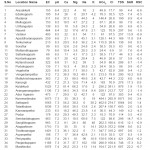Mixed-Ligand Complexes of Palladium (II), Ruthenium (II), Rhodium (III) and Iridium (III) with Triphenyl Phosphine and Dibenzyl Sulphide
R. N. Pandey* and Kalpana Shahi
P. G. Centre of Chemistry (M.U), College of Commerce, Patna - 800 020 (India).
The synthesis and characterization of mixed-ligand Pd(II), Ru(II), Rh(III) and Ir(III) complexes with triphenyl phosphine and dibenzyl sulphide are reported. The complexes have been characterized by analytical, conductance, magnetic susceptibility, IR, electronic, 1H NMR and 31P NMR spectral data. Palladium (II) complex is four-corrdinated square planar and other ruthenium (II), rhodium (III) and iridium (III) are six-coordinated octahedral.
KEYWORDS:Pt-metals; Complexes triphenyl phosphine; Dibenzyl sulphide
Download this article as:| Copy the following to cite this article: Pandey R. N, Shahi K. Mixed-Ligand Complexes of Palladium (II), Ruthenium (II), Rhodium (III) and Iridium (III) with Triphenyl Phosphine and Dibenzyl Sulphide. Orient J Chem 2011;27(1). |
| Copy the following to cite this URL: Pandey R. N, Shahi K. Mixed-Ligand Complexes of Palladium (II), Ruthenium (II), Rhodium (III) and Iridium (III) with Triphenyl Phosphine and Dibenzyl Sulphide. Orient J Chem 2011;27(1). Available from: http://www.orientjchem.org/?p=24812 |
Introduction
Mixed-ligand phosphine complexes of late transition metals are versatile homogeneous catalyst and subject of review.1-6 A variety of catalytic processes involve metal precursors modified with triphenyl phosphine, plays a major role.7-8 The present communication reports synthesis, characterization and structural investigations of some new Pd (II), Ru (II), Rh (III) and lr (III) complexes of triphenyl phosphine and Dibenzyl sulphide. Prior to this work, James et al9 have reported Trichlorotris (dibenzyl sulphide) rhodium (III) as effective catalyst for the hydrogenation of maleic acid and trans-cinnamic acid.
Experimental
All chemicals used were of CP-grade or AR-grade. Solvents were distilled and dried before use. The ligand dibenzyl sulphide (R2S)10 and the precursor complexes 11, 12, 13, 14, and 15 were prepared by the methods reported in literature. The Pd(II) complex was prepared by oxidative addition between precursor complex and 30% ethanolic solution of HCl. The preparation of ruthenium (II) complexes were similar to our earlier method.16 The Rh (III) and Ir (III) complexes were prepared by ligand substitution reactions in benzene with precursors complexes followed by the oxidative-addition using 30% ethanolic solution of HCl. The mixture was stirred for 1 hr on magnetic stirrer and the solid products obtained are listed in table 1.
The IR spectra of the ligands and complexes were recorded on a Perkin-Elmer Model-577 Spectrophotometer in the range 4000-200cm–1 as KBr pellets. The magnetic measurements were made on a gouy balance and the diamagnetic corrections for the ligand molecules were done. Electronic spectra of complexes were recorded on a Beckmann and carl Zeiss (Jenna) spectrophotometer. The molar conductance of complexes (10–3M) were measured in DMF using Wiss-Werkstatter weitheim obb type LBR conductivity meter. 1H and 31P NMR spectra were recorded on Bruker 400 MHz or Varian FX90Q instruments using TMS and orthophosphoric acid as references respectively.
Results and Discussion
Light and air stable ruthenium(II) complexes were prepared by reacting with dibenzyl sulphide in a 1 : 1 molar ratio/excess of in benzene.
 |
Table 1: Click here to View table |
The ligand substitution in in benzene solution yields complex (III) easily but complex (IV) is formed under drastic conditions using excess dibenzyl sulphide or increasing time of stirring. However, bonded hydride ion as well as coordinated carbonyl group could not be replaced. Since CO group has much greater trans-effect than and has greater trans effect than chlorine and the formation of str. III can be explained. The stephensen’s compound under goes more easily ligand substitution giving Trans- (Str. V).
display oxidative addition reaction with ethanolic HCl as below:

This work is licensed under a Creative Commons Attribution 4.0 International License.









